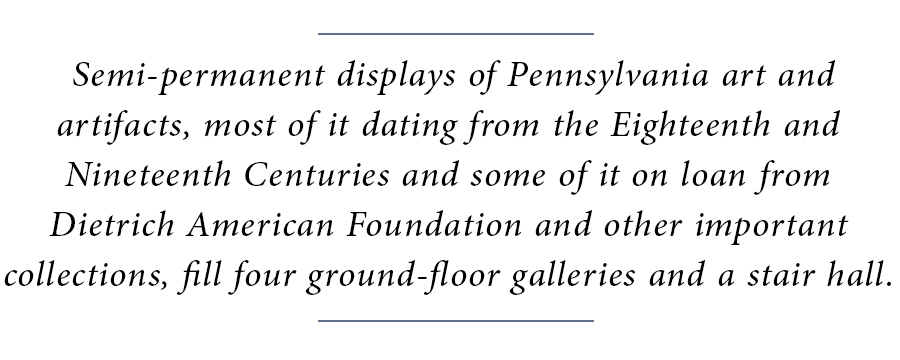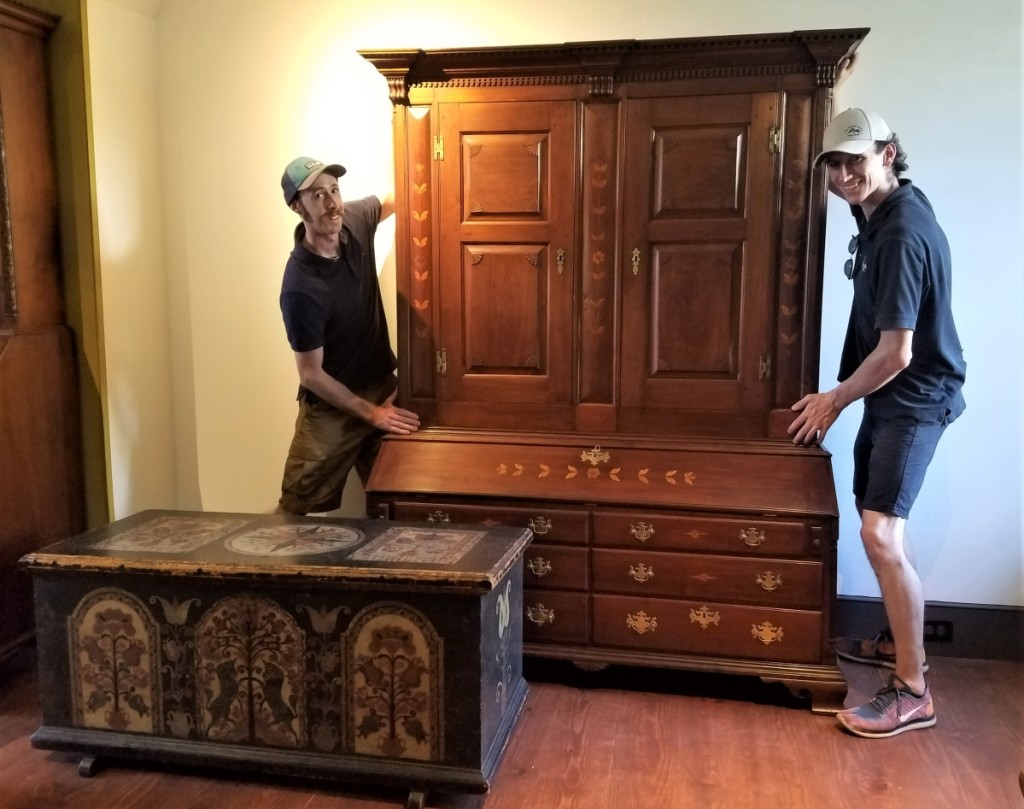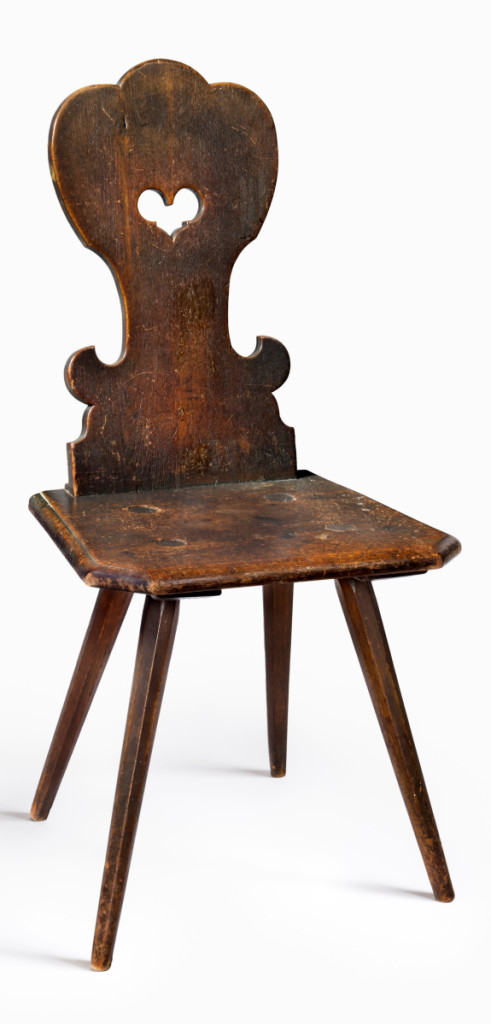-887x1024.jpg)
The earliest section of Dewees Tavern dates from the mid-1700s. Over the years, the building served as a tavern, boarding house, polling place and stagecoach stop.
By Laura Beach
TRAPPE, PENN. – The approaching centennial of the American Wing at the Metropolitan Museum of Art is one of many reminders that everything old may soon be new again. Spurred by Lisa Minardi, updated studies of Pennsylvania German decorative arts are on the upswing, to cite one example of the revival underway.
The expert’s latest project is the new Center for Pennsylvania German Studies, which opened in September in the newly renovated Dewees Tavern, one of five linked sites in Trappe, a historic crossroads roughly 30 miles northwest of Philadelphia. Minardi – who directs the Speaker’s House in Trappe and the Lutheran Archives Center At Philadelphia, where some of Trappe’s important papers are housed – enlisted friends and colleagues in the project, for which collectors Joan and the late Victor Johnson provided seed money. The auctioneers Pook & Pook and Morphy pitched in with moving help and sponsorships.
Semi-permanent displays of Pennsylvania art and artifacts, most of it dating from the Eighteenth and Nineteenth Centuries and some of it on loan from Dietrich American Foundation and other important collections, fill four ground-floor galleries and a stair hall. Twentieth Century pieces include paintings by dealer Hattie Brunner and Trappe native David Ellinger. A fifth gallery features the temporary exhibition “Roots: Ursinus College and the Pennsylvania Germans,” drawn from collections of the now defunct Pennsylvania Folklife Society and on view through December 31. Gavin Ashworth’s photos, underwritten by William K. du Pont, illustrate the accompanying Roots catalog.
Renovations to Dewees Tavern began in February and continued through the summer. Skilled volunteers did most of the carpentry and electrical work, local businesses donated products and services and college students helped out with everything from cataloging to yardwork as the September opening approached. Amendments to the historic building’s interior include new lighting, new visitor amenities and refreshed finishes to floors and walls. Phase two of the project will include HVAC upgrades and improved storage facilities.
Visitors to the Dewees Tavern enter, appropriately, through the taproom before proceeding to the first gallery, where some of the earliest objects are on view. Dated 1744, a domed-top chest with heavy iron straps speaks to the 80,000 German-speaking immigrants who arrived in Pennsylvania by 1775. Ephrata Cloister, founded in 1732, is represented by a hanging cupboard of about 1745. A Chester County spice box from the Nottingham area has line-and-berry inlay and was probably made between 1740 and 1750.
 Lancaster’s high style, a distinctive mix of German and English traditions, is visible in gallery two. A circa 1770-85 high chest of drawers from the Dietrich American Foundation is, in Minardi’s words, “a tour de force of Lancaster carving,” with distinctive stippling enlivening its robustly ornamented bonnet.
Lancaster’s high style, a distinctive mix of German and English traditions, is visible in gallery two. A circa 1770-85 high chest of drawers from the Dietrich American Foundation is, in Minardi’s words, “a tour de force of Lancaster carving,” with distinctive stippling enlivening its robustly ornamented bonnet.
A promised gift to Historic Trappe from William K. du Pont, a Lancaster or Lebanon County wardrobe and desk with mixed-wood inlays was made around 1790. An architectural cornice crowns this rare hybrid form.
Woodbury, Conn., dealer David Schorsch lent a sulfur-inlaid frieze that survives from a 1789 schrank inscribed with the names John and Mary Mennig. Minardi writes that the earliest known examples of sulfur-inlaid furniture are from Lancaster County and date to the 1760s.
Fraktur and other light-sensitive pieces are shown in windowless gallery three, where paint-decorated Mahantongo furniture, Wilhelm Schimmel (1817-1890) carvings, sgrafitto-decorated redware pottery and textiles add an additional jolt of color. A birth and baptismal certificate for Matthias Gilbert was most likely decorated by his uncle Conrad Gilbert (1734-1812) around 1784. After close examination, Minardi attributed the text to a different hand, that of Lutheran minister and Trappe notable Henry Muhlenberg. Two samplers by Elizabeth Schrack (1790-1827), great-granddaughter of Trappe founder Jacob Schrack Sr, add to visitors’ understanding of the close-knit community.
Paint, on canvas and furniture, is the focus of the fourth gallery, whose treasures range from a Trappe tall case clock with a movement by George Hagey (1808-1887) to Charles Hofmann’s (1821-1882) 1874 painting “Montgomery County Alms House,” an arresting landscape view whose landmark features survive today, making it possible, as Minardi writes, to “practically drive through the painting and travel back in time.”
“It’s one of the best chests I’ve ever seen,” Minardi says of a lift-top storage piece made for Catarina Zumbro of Bern Township, Berks County, in 1784. Described as a tour-de-force of the decorator’s art, the piece is from the so-called Black Unicorn group, which includes chests made by several artists between 1777 and 1803. The chest’s central panel is decorated with two of the mythical beasts in rampant posture astride a flowering tree.

Pook & Pook helped with the move-in in late August. On long-term display in Gallery 4 is the circa 1780-1800 Lancaster or Lebanon County, Penn., wardrobe and desk, a promised gift to Historic Trappe from William K. du Pont. One of Minardi’s favorite pieces is Black Unicorn chest made for Catarina Zumbro of Bern Township in Berks County, Penn., in 1784. It is from a private collection. Photo Lisa Minardi.
Minardi explores the intertwined histories of Ursinus College and the Pennsylvania Folklife Society in the temporary exhibit “Roots.” The 2004 Ursinus College graduate returns to a collection she studied as an undergraduate, when she first immersed herself in the region’s decorative arts, especially its fraktur.
“My first exhibition opened in the spring of 2003, a loan show featuring highlights from the college’s Pennsylvania German collection that I installed at the Henry Muhlenberg House and Dewees Tavern Museum,” writes the scholar, who offers a detailed introduction to the collection formed by what later was known as the Pennsylvania Folklife Society, founded in 1949 by professors J. William Frey, Alfred L. Schoemaker and Don Yoder. The society’s initiatives included the scholarly journal The Pennsylvania Dutchman, later called Pennsylvania Folklife, and what came to be known as the Kutztown Folk Festival. Ursinus College acquired the Society’s Pennsylvania German collection in 1968.
“Armed with a vast amount of knowledge but a limited budget, Frey, Schoemaker and Yoder nonetheless managed to assemble a remarkable ensemble of Pennsylvania German material,” writes Minardi, who surveys samplers, redware, metalwork, works on paper and decorated Easter eggs, the earliest dated 1774, in the 116-page Roots catalog, more extensive than the exhibition itself.
“They are wonderful objects – and so little known. It is very timely to shine a spotlight on this great collection as our inaugural exhibition at the new center and in conjunction with the college’s 150th anniversary,” she says.
The collection’s greatest strength is fraktur, of which Ursinus owns more than 125 examples, most now accessible online at https://digitalcommons.ursinus.edu/ursinus_fraktur. When complete, the database will include Minardi’s translations of the text and other cataloging details, plus Ashworth’s photographs. Working with partner institutions and private collectors, she hopes to expand the fraktur database over time.
Adam and Eve are central to two eye-catching examples, one from Lebanon County and dating to around 1785, the other from 1804, attributed to Durs Rudy Sr (1766-1843). Organizers chose a colorful drawing of a seahorse and parrot for the catalog’s cover. Daniel Otto (circa 1770-circa 1820) completed the charming piece between 1800 and 1820.

Board chair, probably Nazareth, Northampton County, Penn., 1750-85. Walnut, red oak. Rocky Hill Collection. This chair is from the Moravian Sisters’ House in Nazareth. Known as a Brettstuhl, the chair’s seat and back is made of sawn boards while the legs were shaped by a plane or knife. Gallery Two.
A growing library and archives on decorative arts, local history and genealogy occupies the center’s second floor, which also accommodates space for viewing light-sensitive works on paper and textiles, and room for classes and workshops.
An exhibition of Montgomery County redware pottery, a subject Edwin Atlee Barber explored in his 1903 book Tulip Ware of the Pennsylvania-German Potters: An Historical Sketch of the Art of Slip-Decoration in the United States, is set to open in late April 2020. “Barber’s book is still the only one on the subject,” marvels Minardi, who is curating the display and writing the accompanying catalog, funded in part by the American Folk Art Society. She anticipates focused presentations of redware from other Pennsylvania counties in the years to come. Looking ahead to spring 2021, the center plans to exhibit fraktur from the Dietrich collection.
Minardi cheerfully describes her current schedule as a “five-ring circus.” Come the merger of the Speaker’s House and the Historical Society on January 1, she will direct what will henceforth be known simply as Historic Trappe. Her duties at the Lutheran Archives Center continue. A doctoral candidate at the University of Delaware, she is completing her dissertation on Pennsylvania Germans in early Philadelphia. She contributed a chapter on Pennsylvania German decorative arts for the forthcoming catalog of the Dietrich collection, is working with Rock Ford Plantation in Lancaster on the installation of the John J. Snyder Jr Gallery of Early Lancaster County Decorative Arts, is writing a catalog of William K. du Pont’s collection and is an adjunct faculty member at the Barnes Foundation in Philadelphia. On top of it all, Minardi and her husband, antiques dealer Philip Bradley, are restoring the 1757 Daniel Hiester house in Sumneytown, Penn. Bradley’s by-appointment shop there is now open.
In a swelling of civic pride for Trappe, supporters gathered in July at one long table set up in the middle of Main Street, between the Speaker’s House and Henry Muhlenberg House, for a dinner of seasonal fare shared with friends and neighbors.
“We’ve really hit our stride in Trappe. Many younger people are getting involved with everything from giving tours and demonstrations to maintaining our gardens and running our weekly farm stand. Some are looking for artistic inspiration in historic design. We are trying to be very approachable. Visitors seem to crave interaction with objects and experts in the field,” says Minardi, who in February 2020 will lead a hands-on fraktur workshop offering tips on recognizing the work of specific artists and evaluating authenticity. Workshops on redware, textiles, metalwork and other topics are in the works.
The Dewees Tavern is at 301 West Main Street. For details on visiting or to purchase the full-color, 116-page catalog Roots: Ursinus College and the Pennsylvania Germans, go to www.historictrappe.org.
Photos by Gavin Ashworth unless otherwise noted.




.jpg)







.jpg)





